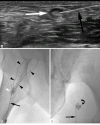Nodal Lymphangiography and Embolization for Postoperative Lymphatic Leakage
- PMID: 40384909
- PMCID: PMC12078084
- DOI: 10.22575/interventionalradiology.2024-0012
Nodal Lymphangiography and Embolization for Postoperative Lymphatic Leakage
Abstract
Intranodal lymphangiography has replaced conventional pedal lymphangiography and has advanced lymphatic intervention. In this method, a lymph node is punctured and Lipiodol is injected to visualize the subsequent lymphatic vessels. This has facilitated the widespread adoption of lymphatic interventional radiology due to the simplicity of the technique and the shortened examination time of the procedure, which allows easy mapping of lymphatic vessels and lymphatic fluid dynamics. With this technique, lymphatic embolization was achieved by injecting an embolic substance into the lymph nodes upstream of the lymphatic leak. Although complications associated with lymphangiography are rare, caution should be exercised due to potential complications associated with the use of Lipiodol. This study summarizes intranodal lymphangiography techniques, complications, and lymphatic embolization.
Keywords: intranodal lymphangiography; lipiodol; lymphatic embolization; lymphocele; lymphorrhea.
© 2025 Japanese Society of Interventional Radiology.
Conflict of interest statement
None
Figures


Similar articles
-
Novel interventional radiological management for lymphatic leakages after gynecologic surgery: lymphangiography and embolization.Gland Surg. 2021 Mar;10(3):1260-1267. doi: 10.21037/gs-2019-ursoc-10. Gland Surg. 2021. PMID: 33842273 Free PMC article. Review.
-
Early Experience in the Management of Postoperative Lymphatic Leakage Using Lipiodol Lymphangiography and Adjunctive Glue Embolization.J Vasc Interv Radiol. 2016 Aug;27(8):1177-1186.e1. doi: 10.1016/j.jvir.2016.05.011. Epub 2016 Jul 1. J Vasc Interv Radiol. 2016. PMID: 27373491
-
Lymphangiography and Lymphatic Embolization for the Management of Pelvic Lymphocele After Radical Prostatectomy in Prostatic Cancer.Cardiovasc Intervent Radiol. 2019 Jun;42(6):873-879. doi: 10.1007/s00270-019-02209-6. Epub 2019 Mar 27. Cardiovasc Intervent Radiol. 2019. PMID: 30919025
-
REPEATED INTRANODAL LYMPHANGIOGRAPHY FOR THE TREATMENT OF LYMPHATIC LEAKAGE.Lymphology. 2015 Jun;48(2):59-63. Lymphology. 2015. PMID: 26714370
-
[Transpedal x-ray lymphangiography and treatment of peripheral lymphatic leakage].Radiologie (Heidelb). 2025 May;65(5):332-338. doi: 10.1007/s00117-025-01439-9. Epub 2025 Mar 28. Radiologie (Heidelb). 2025. PMID: 40153033 Review. German.
References
-
- Wallace S, Jackson L, Greening RR. Clinical applications of lymphangiography. Am J Roentgenol Radium Ther Nucl Med. 1962; 88:97-109. - PubMed
-
- Cope C. Percutaneous transabdominal embolization of thoracic duct lacerations in animals. J Vasc Interv Radiol. 1996; 7:725-731. - PubMed
-
- Cope C, Salem R, Kaiser LR. Management of chylothorax by percutaneous catheterization and embolization of the thoracic duct: prospective trial. J Vasc Interv Radiol. 1999; 10:1248-1254. - PubMed
-
- Nadolski GJ, Itkin M. Feasibility of ultrasound-guided intranodal lymphangiogram for thoracic duct embolization. J Vasc Interv Radiol. 2012; 23:613-616. - PubMed

